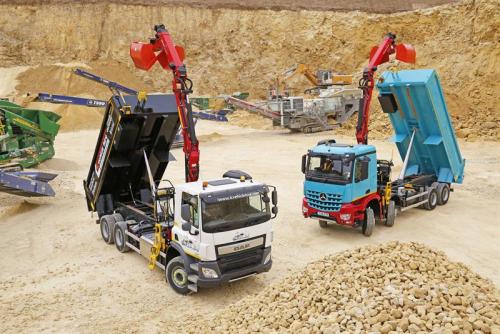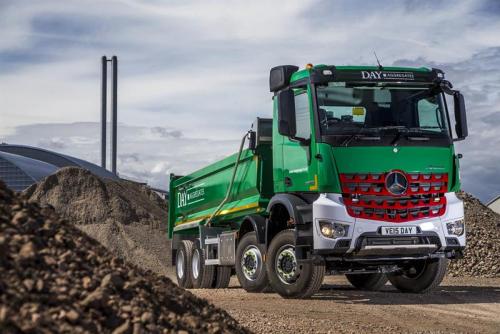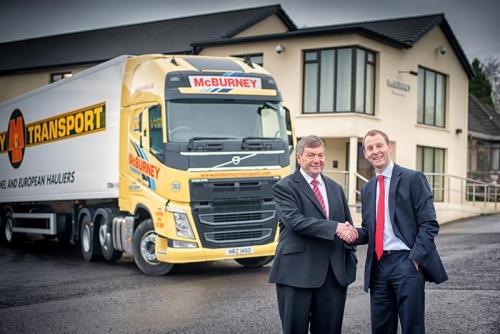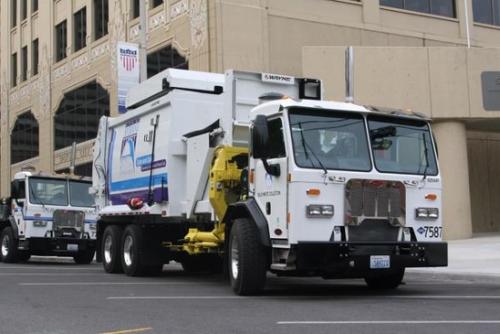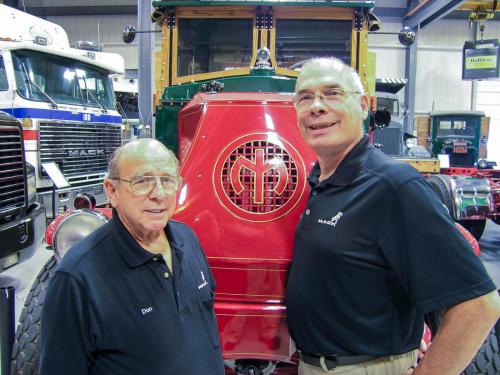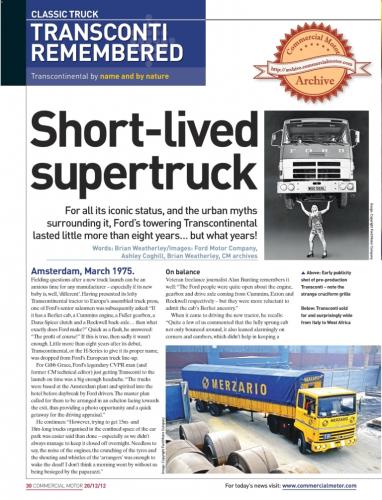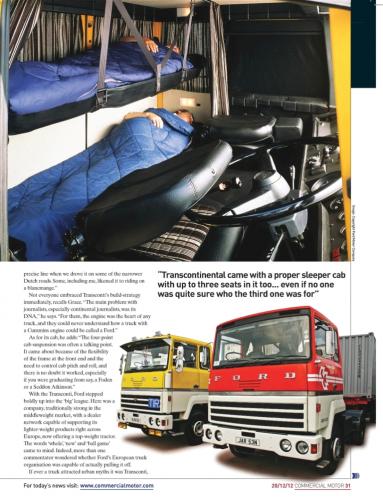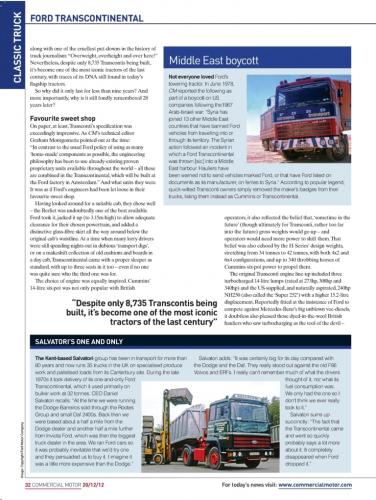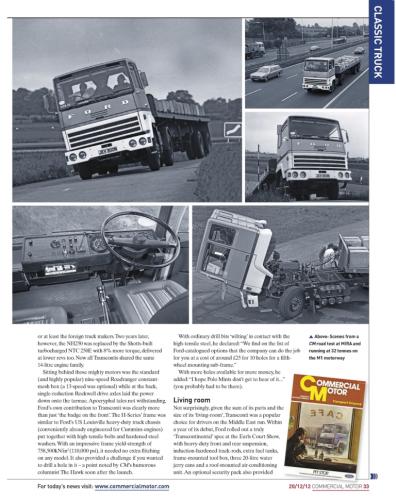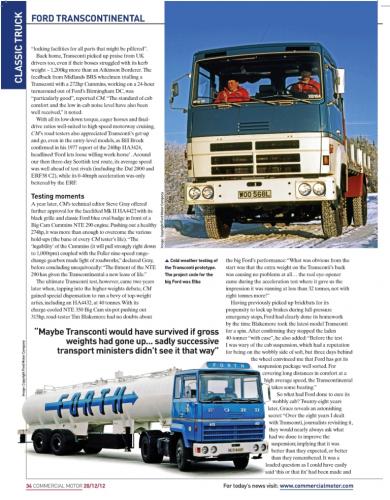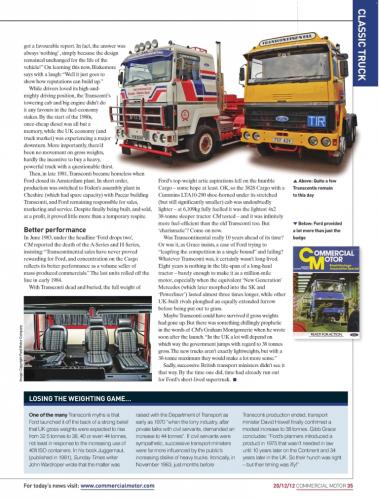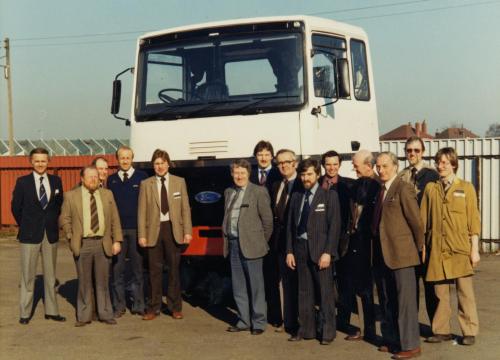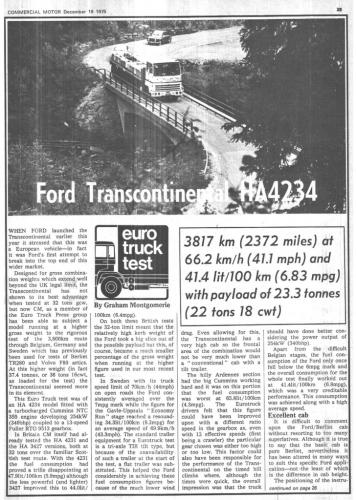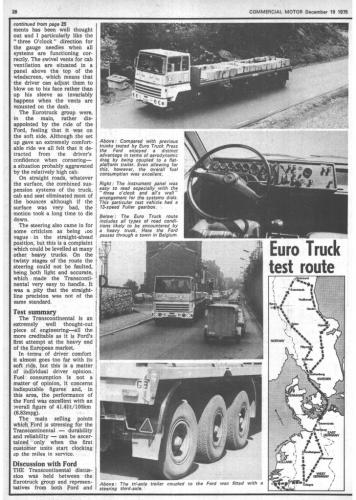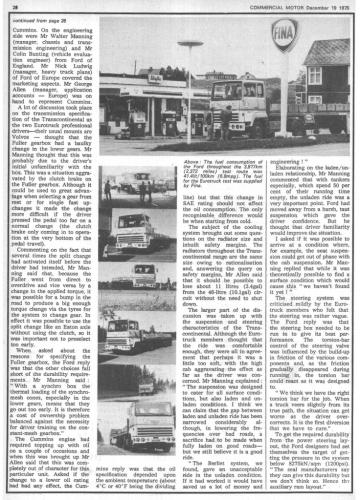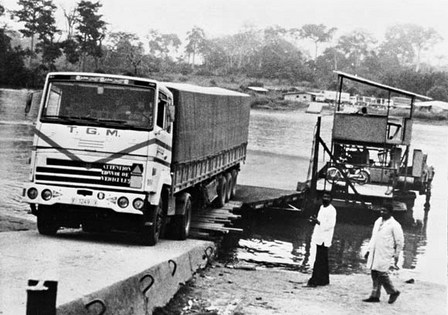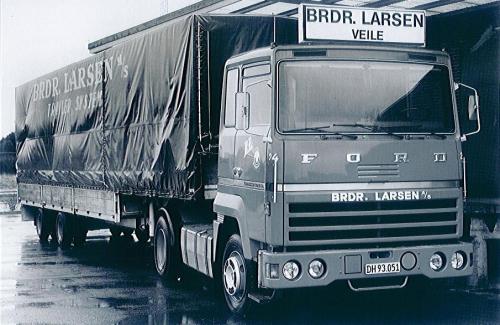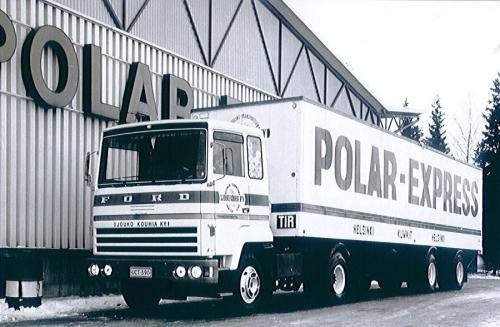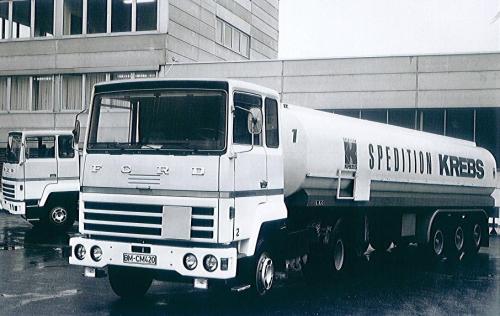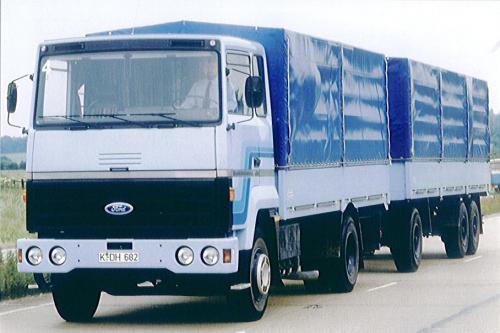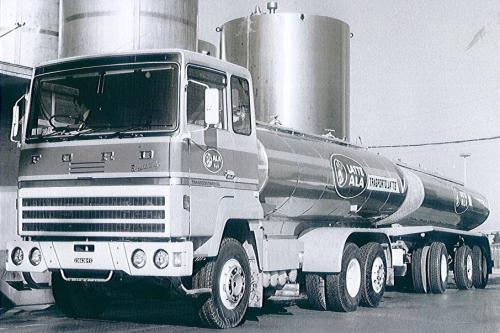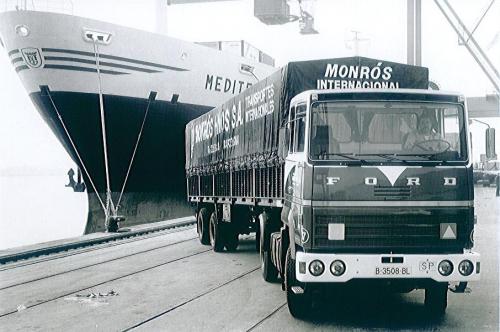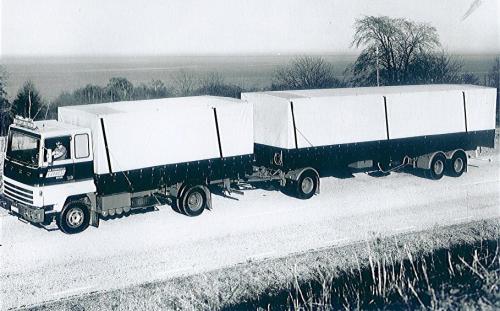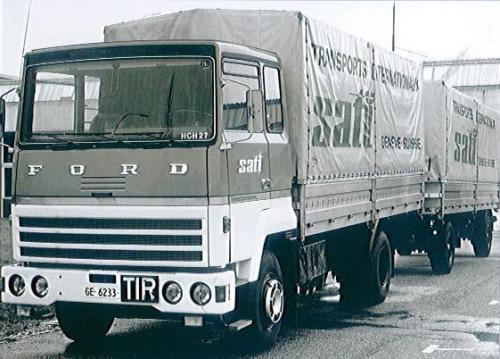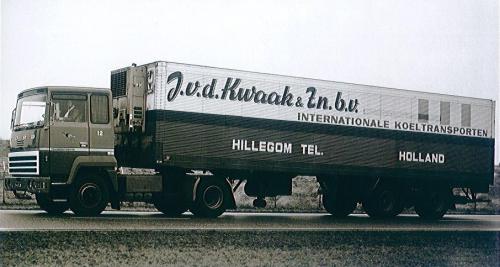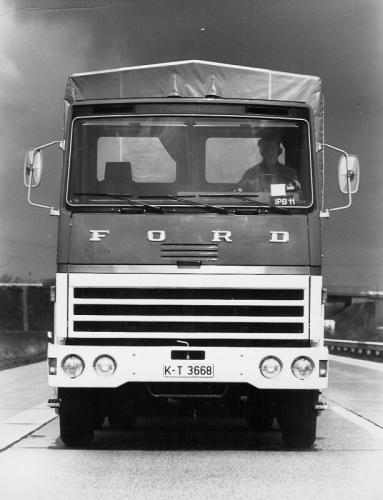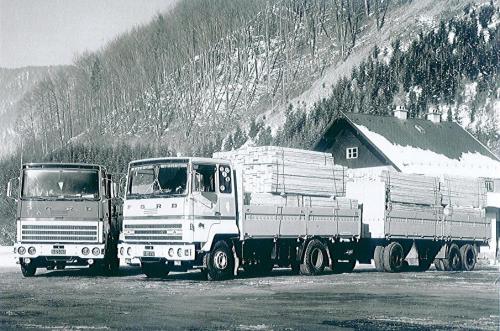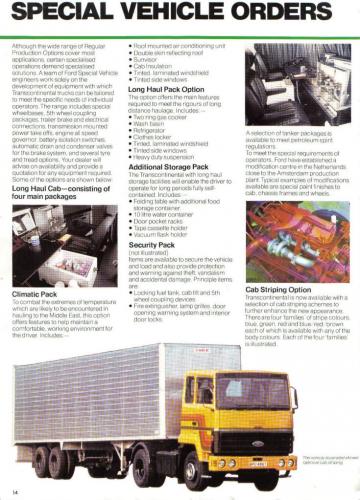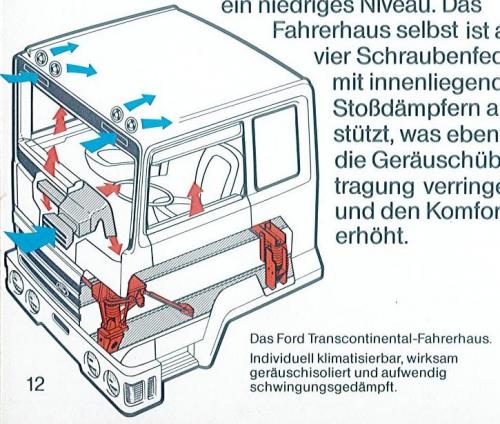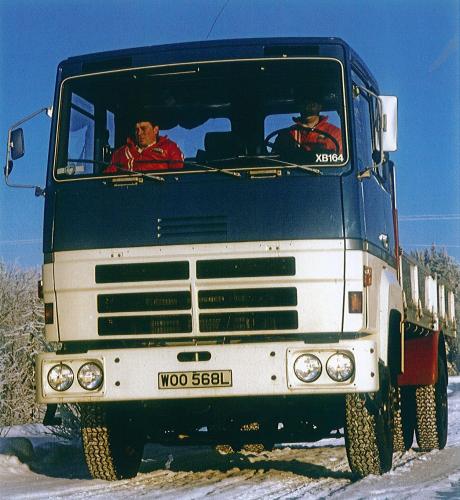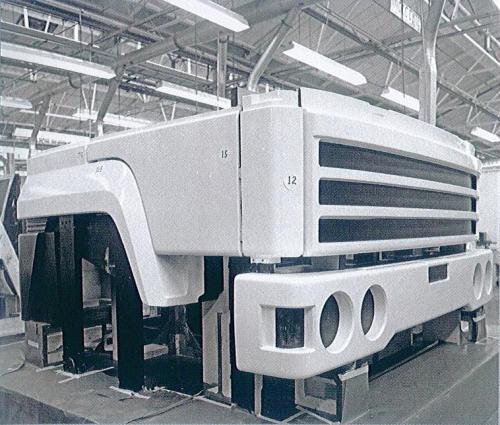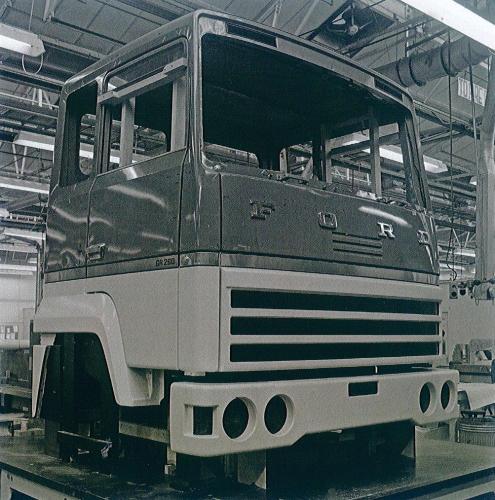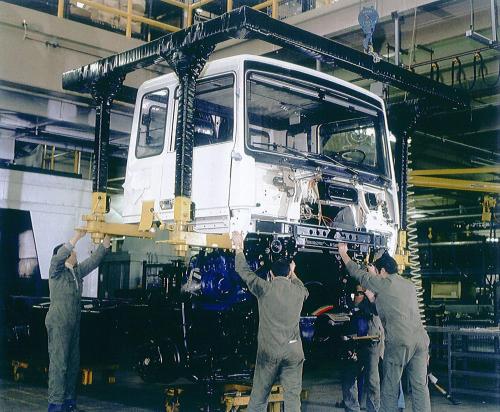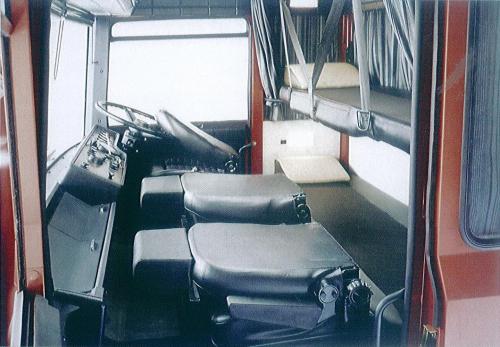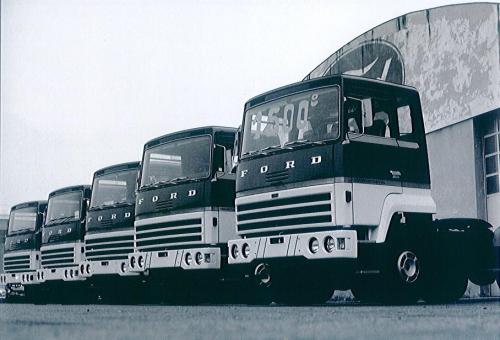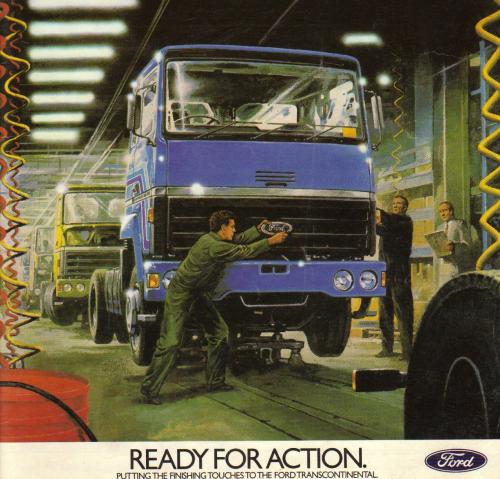
kscarbel2
Moderator-
Posts
18,868 -
Joined
-
Days Won
114
Content Type
Profiles
Forums
Gallery
Events
Blogs
BMT Wiki
Collections
Store
Everything posted by kscarbel2
-
GAZ Press Release / July 28, 2015 GAZ Group invited the truck industry media to put its next generation Ural truck range to the test this month near Yekaterinburg on the unforgiving roads of the Ural forest. With stony slopes, off-road conditions and fast running water, the landscape closely matches the actual operational conditions that Ural trucks experience in the hands of oil industry exploration teams. The demonstration showed off the unique off-road capabilities of Ural NEXT, as well as its high levels of comfort and reliability. Journalists comments: Autoreview: "This truck, as well as GAZelle NEXT, instills pride in our auto industry. I have never driven such a cozy, harmonious and "light" by sensations heavy all-terrain vehicle..." Auro@Mail.Ru: "In addition, NEXT amazed by its running-away: there are five tons of soil in the body, and the dump truck does not notice it completely, accelerating extremely briskly. You have only to manage changing speeds on the 9-speed gearbox! Driveability, brakes, and dynamics - everything is like in a passenger car. Ambience around the workplace is perfect: exemplary ergonomics and a lot of nice "gadgets" - glass holders, bottle holders, cruise control, radio control on the steering wheel, electric window lifters..." Kolesa.ru: "How I like a noble grumbling of the diesel "six"! An empty vehicle starts off easily with the third gear, and we roll out to the site. A bank-to-bank maneuverer both forward and backward, backing into a perpendicular park - all this is done easily, the vehicle managed not to knock any of the cones, so visibility is really all right". Video - https://www.youtube.com/watch?v=-FH-6jDJuRI
-
Tim Maikshilo isn’t fooling me - It's the Vegemite
kscarbel2 replied to kscarbel2's topic in Odds and Ends
Working around the globe really opens your eyes and expands your thought process, as you're no doubt experiencing. BUT, flying is no longer pleasant with the never-ending delays, late arrivals and subsequent missed connections and cancellations, and the constant jet lag back and forth gives you grey hair. -
Somalia, a lawless abyss. Why would we allow them in (legally I presume) when we already have a steady flow of criminals pouring in over our southern border from another lawless abyss? We have a massive ongoing problem, dare I say crisis, unfolding in our country............and yet the government refuses to publicly acknowledge it.
-
Tim Maikshilo isn’t fooling me - It's the Vegemite
kscarbel2 replied to kscarbel2's topic in Odds and Ends
I have a meeting in KL (Kuala Lumpur) next month. -
Finally, a picture of a proper Commonwealth truck. Now, how about some of Fodens, ERFs and Seddon Atkinsons? They should be broken in just about now. A Scammell or Bedford TM would be acceptable as well. I recall an ERF-built Western Star COE running down there too.
-
Tim Maikshilo isn’t fooling me - It's the Vegemite
kscarbel2 replied to kscarbel2's topic in Odds and Ends
Okay, okay, now you've done it.............because I won't be able try out a bag until............probably when I run through Hong Kong next month. I know I can get the jars of Sanitarium Marmite there. -
Transport Engineer / August 6, 2015 LC Vehicle Hire, of Leeds, has ordered another 100 new Thompsons tippers this year, establishing a new record for the tipper bodies manufacturer from a single customer – of 1,150 tippers since 2002. Most have been all-steel Loadmasters fitted to 8x4 and 6x4 chassis, predominantly DAF, MAN and Mercedes-Benz. "First and foremost, our business is built upon the reliability of the trucks we offer," comments LC Vehicle Hire sales director Paul Bumford. "Tippers have the hardest life of any type of truck, so the ideal vehicle for us is the one that returns zero unscheduled downtime, while also needing the minimum amount of maintenance," he continues. "Strength, durability and reliability are what we are looking for, so a tipper body's quality of design and manufacture are paramount." Bumford says that having purchased Thompsons' tipper bodies for over 13 consecutive years, he has ample proof of those qualities. In fact, it was the building of Thompsons first northern factory in Blackburn that led to LC Vehicle Hire buying its first tippers form the company. Now, with three factories in the town, Blackburn produces more tipper bodies than its Croydon counterpart. As well as the higher gvw tipper types, Thompsons has also delivered dropside tippers on 7.5 and 18-tonne rigids, Hyva skiploaders and hookloaders, as well as special body types, such as bespoke lighting platforms (built by sister company Charlton) to LC Vehicle Hire. "When we come to sell our tippers, we always find that a vehicle with a Thompsons body is worth more than one without," comments Bumford. "Judged over its whole life costs, the Thompsons product is exceptionally cost-effective." .
-
Transport Engineer / August 5, 2015 Construction specialist Day Aggregates is running its first Mercedes-Benz truck for more than a decade, having taken delivery of an 8x4 Arocs from Surrey and Sussex dealer Rossetts Commercials. Its new Arocs 3240K was specified with the straight-six 394bhp engine mated to a Mercedes PowerShift automated gearbox. And, with an Aggrelite steel tipping body by Boweld plus a full complement of safety features and on-board weighing, it's delivering a 19.5-tonne payload. "Every kilo counts in our operation and that's a pretty good figure," states group transport manager Chris Cooling, who is responsible for Day Aggregates' mixed-marque fleet of 150 trucks, most eight-wheelers. "We used to run Mercedes-Benz 18-tonners, but over time they became a bit heavy, and we've previously steered clear of its 32-tonners for the same reason," he continues. "But the 8x4 Arocs is right on the money in terms of weight and payload capacity. It also looks to be every bit as strong and well-built as you'd expect and, if it lives up to its early promise, is going to be more fuel-efficient than any of the other eight-wheelers we have in the yard." Cooling says it was these factors, coupled with the persistent door knocking of Rossetts' sales people, that convinced the firm to give the truck a trial. "Day Aggregates is the biggest tipper operator in our area," observes Rossetts Commercials dealer principal Perry Reeves. "This is probably the most important vehicle we have supplied over the last couple of years," he continues. "I've every confidence that, backed-up by Rossetts' 24-hour after sales support, the Arocs will prove itself worthy of a more substantial role in the Day Group fleet." Day Aggregates' new Arocs is based at its Newhaven, East Sussex, depot and is currently working on the £94-million project to build a relief road between Bexhill-on-Sea and Hastings. .
-
Transport Engineer / August 5, 2015 Northern Irish operator McBurney Transport has ordered 25 Euro 6 Volvo trucks, as part of its fleet replacement cycle for 2015, including 15 FH 500 6x2 Globetrotters and 10 FM 460 Globetrotter models. Supplied by Dennison Commercials, the latest additions are all fitted with emergency braking and lane keeping support, in preparation for November's introduction of the General Safety Regulations. The trucks are also specified with the Dynafleet telematics system. McBurney is one of the largest Volvo operators anywhere in Ireland, having taken more than 1,000 vehicles from Dennison in the past 45 years. In October 2009, it was the first operator in the UK and Ireland to take delivery of the flagship Volvo FH16-700. Then, in 2011, McBurney took delivery of one of the first FH16-750 models, and was one of the first to order the new Volvo FH, in its 2013/14 truck delivery. "We are constantly updating our vehicles to ensure we have a reliable provision of services for our customers," says Norman McBurney, managing director. "We continue to purchase from Dennisons because Volvo is a consistently reliable and innovative product and we have been well supported by Dennisons locally over the years." .
-
KLXY / August 3, 2015 The City of Spokane unveiled its newest compressed natural gas garbage trucks Monday morning. Overall, the city will replace 90 trucks over the next seven years, cutting its green house gas emission by 20 percent. While CNG trucks cost around $30,000 more than standard diesel, the city says that cost is recouped in three years, through fuel and maintenance savings. The city estimates the new CNG vehicles, which cost $360,000 per unit, will save the city around $8,000 a year per truck compared to the older diesel models. The new CNG trucks are expected to last about 10 years, while the natural gas tanks on the new vehicles have to be recertified every five years. "One of the things you're going to notice is the emissions package on these trucks, much smaller, much tighter, much less maintenance than compared to a diesel powered truck so it's huge for us," said Scott Windsor, Director of Solid Waste Collections for the City of Spokane. Compressed natural gas trucks aren't more fuel efficient but gas is less expensive than diesel by about a dollar. For now, the CNG trucks will fill up at Avista Utilities until the city finishes a refueling station at its new utility central service center in about two weeks. Related reading - http://www.peterbilt.com/products/alternative-fuels/320/ .
-
Note that Volvo is replacing a knowledgeable Mack veteran with a Latin and English instructor. Apparently, no younger ex-Mack people (the Lehigh Valley has many) want to work for Volvo. Don performed the job so well, in the footsteps of my dear late friend Colin Chisholm, because he had an intimate knowledge of Mack Trucks from years of service. With all due respect to Mr. Kitsock, the simple fact that he never worked for (within) the company for any period of time makes him completely unqualified for the position.
-
Trucking News / August 4, 2015 Don Schumaker, curator of Mack Trucks Historical Museum, has received the Historian of the Industry Award from the American Truck Historical Society (ATHS). The award recognizes individuals who have been diligent in their pursuit of the history of the trucking industry. As curator of the Mack Trucks Historical Museum, Schumaker is responsible for dozens of trucks and exhibits that proudly display the history of Mack Trucks to thousands of visitors each year. “Don has made significant contributions to protecting and promoting the history of Mack Trucks, and we’re proud to see his efforts recognized with the Historian of the Industry Award,” said Stephen Roy, president of Mack Trucks North America. “Through his decades of service, first as an employee and then as curator of the museum, Don has been a true ambassador for Mack.” Schumaker joined Mack as a test lab mechanic in December 1957. He earned his engineering degree from Lafayette College while taking night classes and continuing to work at Mack. After advancing through a number of positions within the test lab, he was named manager of vehicle performance, a position he held until his retirement in 1995 after 38 years of service. After enjoying retirement for six short months, Schumaker was back with the Bulldog, joining the Mack Trucks Historical Museum staff in June 1996. He was named co-curator of the museum in 1997 and curator in 2008. Schumaker has announced his retirement from the Mack Trucks Historical Museum at the end of this year. Michael Kitsock has been named Schumaker’s successor and has already started work at the museum. Kitsock, a Pennsylvania native, is a former Latin and English instructor with a passion for antique and historic trucks. He is affiliated with several antique and historical truck organizations, including the ATHS, Antique Truck Club of America and the Schuylkill Historical Fire Society Museum. Located at the Mack Customer Center in Allentown, Pa., the Mack Trucks Historical Museum is a separate, not-for-profit corporation that explores the history of Mack and demonstrates the industry-leading manufacturing techniques that have kept Mack at the forefront of heavy-duty trucking. In addition to the museum, the Mack Customer Center is home to the Mack Heritage Center, a Mack showroom and a performance track where customers can test drive Mack vehicles .
-
Computer hacker’s demonstrate they can take control of vehicles
kscarbel2 replied to kscarbel2's topic in Trucking News
Fiat Chrysler waited 1-1/2 years before telling NHTSA about hacking vulnerability Bloomberg / August 5, 2015 Fiat Chrysler Automobiles (FCA) waited 18 months to tell federal safety regulators about a security flaw in radios being installed in more than a million vehicles that hackers later exploited to seize control of a Jeep last month. The automaker says it was working on a fix and didn’t consider the problem a safety defect. But the National Highway Traffic Safety Administration (NHTSA) saw otherwise. Eight days after finally being notified by FCA, the NHTSA pushed Fiat Chrysler last month to recall 1.4 million cars and trucks -- the first recall prompted by cybersecurity safety concerns. The episode came just days before Fiat Chrysler agreed to a $105 million penalty to settle complaints about its recall performance on other issues and as NHSTA faces its own criticism for failing to promptly get unsafe vehicles off the street. Cybersecurity threats present a new dimension to the problem, one that critics say demands even faster response to keep hackers from worming their way into vehicles and causing havoc. A Senate report last year concluded only two of 16 automakers had the ability to detect and respond to a hacking attack. “We want to make sure the automakers and regulators stay ahead of this,” said Mark Rechtin, autos editor for Consumer Reports and a former reporter for Automotive News. "While there have been no reports of hackers being able to access random cars, “once it happens, and it happens badly, no one will be able to trust their cars.” Hacking details The researchers who took control of a Jeep will detail their exploit at the Black Hat cybersecurity conference in Las Vegas Wednesday. Two days later at hacking conference in Los Angeles, another hacker said he will reveal vulnerabilities with General Motors’ OnStar navigation system mobile app. And there’s been a rise in auto thefts using key-cloning systems for electronic fobs. To help focus regulators’ attention on cyberthreats, the U.S. Senate promised the chronically understaffed agency more resources and personnel in a bill passed last week. But the funding is contingent on NHTSA making numerous changes in the wake of a Transportation Department Inspector General’s report critical of its slow response in recalls with more typical vehicle issues. On the cyber front, NHTSA has an open audit of the Fiat Chrysler recall to make sure it includes all potentially affected vehicles and the company’s fix actually works, agency spokesman Gordon Trowbridge said. There’s also an active investigation into Harman International Industries Inc., supplier of the Uconnect communications system used by Fiat Chrysler. Same vulnerability Another immediate focus is whether other automakers with similar systems have the same vulnerability, Trowbridge said. The agency has been having regular conversations with manufacturers and suppliers on cybersecurity, he said. Automakers have reached out to NHTSA “to let us know they are aware of the issue and the steps they are taking to assess their own security protections,” Trowbridge said. The auto industry’s two biggest trade groups, the Alliance of Automobile Manufacturers and the Association of Global Automakers, said July 14 they would form an information-sharing and analysis center by the end of the year to collaborate against emerging cyber threats. The Fiat Chrysler hacking experiment should serve as “a wake-up call” to automakers to be more proactive to secure software and other systems, or else they’ll face new government regulations mandating security, said Ken Westin, a security analyst with the cybersecurity company Tripwire Inc. based in Portland, Ore. Lacks expertise Westin is skeptical of government regulation and isn’t convinced that an agency like NHTSA has the resources and expertise to oversee cybersecurity. Harman needs to let independent researchers test its devices and software, Westin said. Hacking vulnerabilities are often created not because products and software from vendors are insecure, but because of how they are applied and configured in a certain setting, he said. “A lot of the automakers are going to start demanding independent verification” of software and products, he said. “We see this in other areas of security when there’s a breach from a third party.” The vulnerability exposed in the Jeep hacking incident is unique to Fiat Chrysler, Harman CEO Dinesh Paliwal said in an interview Tuesday. Automakers modify radios and entertainment systems to suit their customers, he said. “This does not exist, to our assessment, in any other vehicle,” he said. A Harman spokesman declined to comment on why it took 18 months to inform regulators about the vulnerability. Third party Documents Fiat Chrysler filed with NHTSA note that it didn’t consider the software issue, identified by a third party in January 2014, to be a safety defect under U.S. law. Under the Motor Vehicle Safety Act, which governs how and when recalls are conducted, automakers must notify NHTSA within five days of discovering a flaw that presents an unreasonable risk to public safety. Fiat Chrysler said in a statement it advised NHTSA of the security issue “in a reasonable and timely manner.” The company said it’s “conducting a remedial campaign as a safety recall in the interest of protecting its customers” out of “an abundance of caution.” The company said it contacted NHTSA after the hackers informed the company of their plan to publicize the security flaw at Black Hat, including information to facilitate unauthorized and unlawful access to Fiat Chrysler vehicles. Other products The NHTSA notice of its Harman investigation noted that the vulnerability may exist in products it supplies to other companies. Harmon’s website indicates it supplies entertainment systems to BMW AG and as well as the Mercedes-Benz brand of Daimler AG. Both companies said their vehicles were safe. BMW’s information and entertainment system is separated from the safety-relevant driving system by several gateways that implement firewalls, message filtering and message blocking, the company said in an e-mailed statement. Mercedes-Benz spokesman Benjamin Oberkersch said the German manufacturer is taking comprehensive measures to protect its cars from hacking attacks. He declined to comment on the Harman investigation. U.S. Sens. Edward Markey, D-Mass., and Richard Blumenthal, D-Conn., introduced legislation on July 21 that would direct NHTSA and the Federal Trade Commission to establish rules to secure cars and protect consumer privacy. Rating system The senators’ bill would also establish a rating system to inform owners about how secure their vehicles are beyond any minimum federal requirements. The lawmakers released a report in 2014 on gaps in car-security systems, concluding that only two of 16 automakers had the ability to detect and respond to a hacking attack. Markey said in an interview that congressional hearings into the GM ignition switch and airbags made by Takata Corp. showed that understaffed and underfunded regulators have been sometimes slow to react. “This whole issue of computers on wheels is something new,” Markey said. “Based upon what happened over the last several years with Takata and all these other issues, we need to ensure they’ve got the resources.” -
Senator 'alarmed' by reports U.S. military families harassed Reuters / August 5, 2015 A U.S. Senator said on Wednesday he was alarmed by reports of an FBI alert that relatives of U.S. military personnel in Colorado and Wyoming were harassed outside their homes by Middle Eastern men who may have had them under surveillance. "I am alarmed by reports out of Denver that military members' families have been harassed outside their homes and may be under surveillance," U.S. Senator Cory Gardner, a Republican from Colorado, said in a statement. "This news comes less than two weeks after FBI Director James Comey, speaking in Denver, warned of the heightened threat from the Islamic State that Colorado specifically faces." According to a copy of the alert published online by Denver's CBS affiliate, the wife of a U.S. military member was approached in front of her home in Colorado in May by two men who stated she was married to a U.S. interrogator. Similar incidents in Wyoming were reported to the FBI throughout June, the alert read. An FBI media coordinator in Denver did not immediately respond to a request for comment. According to the copy of the alert published by CBS4, the two men laughed when the woman in Colorado denied their claims that she was married to a U.S. interrogator. They then drove away in a dark-colored, four-door sedan with two other Middle Eastern males in the vehicle. The woman had observed the car in the neighborhood on previous occasions, the alert said. It also said family members of military personnel were confronted by Middle Eastern men outside their homes in Wyoming "on numerous occasions" during June. "The males have attempted to obtain personal information about the military members' family members through intimidation," the copy of the alert read. "The family members have reported feeling scared." Gardner said the FBI had alerted all Colorado law enforcement agencies, and that his office is in contact with the appropriate officials. "I will continue to closely monitor the situation, and I encourage Coloradans to report suspicious behavior to the FBI," his statement said.
-
Naval officer could face discipline for using handgun at recruiting center The Washington Post / August 5, 2015 In the days after the attack on military facilities in Chattanooga, Tenn., last month, a complicated picture of what occurred began to emerge. Among the details: At least one service member, Navy Lt. Cmdr. Timothy White, opened fire on the shooter using his personal firearm before the shooter was killed by police. The attack on the Naval Reserve support center in Chattanooga left four Marines and a Navy sailor dead, and it spawned a debate about whether the U.S. military should arm more service members who work out of small, unguarded facilities like recruiting stations and reserve centers. But it also spawned questions about whether White could face discipline for carrying and discharging a privately owned handgun on federal property, where it was not allowed. On Saturday, conservative columnist Allen B. West took the issue on, saying that he could "confirm that the United States Navy is bringing charges against Lt. Cmdr Timothy White for illegally discharging a firearm on federal property." He did not identify his source, and followed by criticizing Pentagon leaders, the Navy and President Barack Obama. "Can you imagine the message this sends to ISIS and all the enemies of America?" West wrote, using an acronym for the Islamic State militant group. "We are going to end his career and court-martial a man who drew his sidearm to protect his command, and the assigned Sailors and Marines. " Presidential candidate Jim Webb, D-Va., a Marine war hero and former Navy secretary, also raised concerns Saturday night on Twitter: "Navy charging LCDR Tim White w/ a crime for trying to defend our sailors & Marines in.Chattanooga? He deserves a medal, not an indictment." Perhaps aware of the questions his tweet raised, Webb followed up with more context Sunday. "Before tweeting last night, we confirmed with a defense official that the Navy was seriously considering charging LCDR Timothy White." Webb followed up with: "The charge being considered is illegally discharging a firearm on federal property. No on the record comment was offered." The Navy responded to questions about the case Sunday on its Facebook page, saying that "stories of Navy personnel being charged with an offense are not true. "There is still a long way to go in reviewing the facts of this tragic incident, but at this time we can confirm no service member has been charged with an offense," the Navy added. On Monday, officials at the Pentagon went even further, telling The Washington Post that criminal charges are unlikely in White's case. They spoke on condition of anonymity, citing the open investigation. Navy Cmdr. William J. Marks, a service spokesman, said that White's actions remain under review as part of a broader assessment, known as a preliminary inquiry, into what occurred in Chattanooga. "Until the facts of that preliminary inquiry have all been reviewed, it is simply too early to speculate on what may happen with any particular individual," Marks said. The situation has continued to raise questions, though. Some have noted that the Navy said no service member has been charged with an offense "at this time," leaving the possibility it could occur later. Tens of thousands of supporters also have signed an online petition to the White House for White, saying he and anyone else who opened fire on the shooter - Mohammad Youssef Abdulazeez, 24 - deserves a medal for valor rather than a punishment. Among those who have weighed in are actor James Woods ("Yes, Timothy White should be 'punished.' Make him an Admiral") and television personality Montel Williams, a Navy veteran ("Jim the Navy HASN'T charged him. Investigating sure, but NO charge is pending. Let's let them actually do it first?") The attack on the reserve center killed Gunnery Sgt. Thomas Sullivan, 40; Staff Sgt. David Wyatt, 35; Sgt. Carson A. Holmquist; Lance Cpl. Squire D. "Skip" Wells, 21; and Navy Petty Officer 2nd Class Randall Smith, 26. Abdulazeez was killed by police officers responding to the attack.
-
-
Euro Truck Test – The New Ford Transcontinental HA4234 Heavy Tractor Commercial Motor / December 19, 1975 When Ford Motor Company launched the Transcontinental heavy truck earlier this year, it stressed that this was a European vehicle—in fact it was Ford's first attempt to break into the top end of this wider market. Designed for gross combination weights which extend well beyond the UK legal limit, the Transcontinental has not shown to its best advantage when tested at the UK’s 32 tons GCW, but now Commercial Motor, as a member of the Euro Truck Press group, has been able to subject a Transcontinental running at a higher gross weight to the rigorous test of the 3,800km route through Belgium, Germany and Sweden which has previously been used for tests of Berliet TR280 and Volvo F89 artics (tractors). At this higher weight (in fact 37.4 tons, or 36 tons 16cwt, as loaded for the test) the Transcontinental seemed more in its element. The Transcontinental tested was a model HA 4234 (HA=tractor / 42 ton GCW / 340hp) model fitted with a turbocharged Cummins NTC 355 engine developing 254kW (340bhp) coupled to a 13-speed Fuller RTO 9513 gearbox. In Britain Commercial Motor itself had already tested the HA 4231 and the HA 3427 versions, both at 32 tons over the familiar Scottish test route. With the 4231 the fuel consumption had proved a trifle disappointing at 47.91it/100km (5.9mpg) although the less powerful (and lighter) 3427 improved this to 44.01it/ 100km (6.4mpg). On both these British tests, the 32-ton limit meant that the relatively high kerb weight of the Ford took a big slice out of the possible payload but this, of course, became a much smaller percentage of the gross weight when running at the higher figure used in our most recent test. In Sweden with its truck speed limit of 70km/h (44mph) on open roads, the Ford consistently averaged over the 7mpg mark while the figure for the Gavle-Uppsala "Economy Run" stage reached a resounding 34.31it/100km (8.2mpg) for an average speed of 69.9km/h (43.3mph). The standard trailer equipment for a Euro Truck test is a tri-axle “TIR” tilt type, but because of the unavailability of such a trailer at the start of the test, a flat trailer was substituted. This helped the Ford considerably in achieving these fuel consumption figures because of the much lower wind drag. Even allowing for this, the Transcontinental has a very high cab so the frontal area of the combination would not be very much lower than a "conventional" cab with a tilt trailer. The hilly Ardennes section had the big Cummins working hard and it was on this portion that the fuel consumption was worst at 65.8 lit/100km (4.3mpg). The Euro Truck drivers felt that this figure could have been improved with a different speed ratio in the gearbox as, even with 12 effective speeds (first being a crawler) the particular gear chosen was either too high or too low. This factor could also have been responsible for the performance of the Transcontinental on the timed hill climbs where, although the times were quick, the overall impression was that the truck should have done better considering the power output of 254kW (340bhp). Apart from the difficult Belgian stages, the fuel consumption of the Ford only once fell below the 6mpg mark and the overall consumption for the whole test finally worked out at 41.41it/100km (6.8mpg), which was a very creditable performance. This consumption was achieved along with a high average speed. Excellent cab It is difficult to comment upon the Ford/Berliet cab without resorting to too many superlatives. Although it is true to say that the basic cab is pure Berliet, nevertheless it has been altered in many ways to suit this specific Ford application—not the least of which is the difference in cab height. The positioning of the instruments has been well thought out and I particularly like the "three o'clock" direction for the gauge needles when all systems are functioning correctly. The swivel vents for cab ventilation are situated in a panel above the top of the windscreen, which means that the driver can adjust them to blow on to his face rather than up his sleeve as invariably happens when the vents are mounted on the dash. The Euro Truck group were for the most part disappointed by the ride of the Ford, feeling that it was on the soft side. Although the set up gave an extremely comfortable ride, we all felt that it detracted from the driver's confidence when cornering— a situation probably aggravated by the relatively high cab. On straight roads, whatever the surface, the combined suspension systems of the truck, cab and seat eliminated most of the bounces although if the surface was very bad, the motion took a long time to die down. The steering also came in for some criticism as being too vague in the straight-ahead position, but this is a complaint which could be leveled at many other heavy trucks. On the twisty stages of the route the steering could not be faulted, being both light and accurate, which made the Transcontinental very easy to handle. It was a pity that the straight-line precision was not of the same standard. Test summary The Transcontinental is an extremely well thought-out piece of engineering—all the more creditable as it is Ford's first attempt at the heavy end of the European market. In terms of driver comfort, it almost goes too far with its soft ride, but this is a matter of individual driver opinion. Fuel consumption is not a matter of opinion, it concerns indisputable figures and, in this area, the performance of the Ford was excellent with an average figure of 41.41it/100km (6.83mpg). The main selling points which Ford is stressing for the Transcontinental — durability and reliability — can be ascertained only when the first customer units start clocking up the miles in service. Discussion with Ford The Transcontinental discussion was held between the Euro Truck group and representatives from both Ford and Cummins. On the engineering side were Mr. Walter Manning (manager, chassis and transmission engineering) and Mr. Colin Bunting (vehicle evaluation engineer) from Ford of England. Mr. Nick Ludwig (manager, heavy truck plans) of Ford of Europe covered the marketing aspects. Mr. George Allen (manager, application accounts — Europe) was on hand Ito represent Cummins. A lot of discussion took place on the transmission specification of the Transcontinental as the two Euro Truck professional drivers—their usual mounts are Volvos — thought that the Fuller gearbox had a balky change in the lower gears. Mr. Manning thought that this was probably due to the driver's initial unfamiliarity with the box. This was a situation aggravated by the clutch brake on the Fuller gearbox. Although it could be used to great advantage when selecting a, gear from rest or for single fast up-shifts it made the change more difficult if the driver pressed the pedal too far on a normal change (the clutch brake only coming in to operation at the very bottom of the pedal travel). Commenting on the fact that several times the split change had activated itself before the driver had intended, Mr. Manning said that, because the Fuller went from direct to overdrive and vice versa by a change in the applied torque, it was possible for a bump in the road to produce a big enough torque change via the tyres for the system to change gear. In effect it was possible to use the split change like an Eaton axle without using the clutch, so it was important not to preselect too early. When asked about the reasons for specifying the Fuller gearbox, the Ford reply was that the other choices fall short of the durability requirements. Mr. Manning said: "With a synchro box, the thermal loading of the synchromesh cones, especially in the lower gears, means that they go out too early. It is therefore a cost of ownership problem balanced against the necessity for driver training on the constant-mesh gearbox." The Cummins engine had required topping up with oil on a couple of occasions and when this was brought up, Mr. Allen said that this was completely out of character for this particular unit. Asked if the change to a lower oil rating had had any effect, the Cummins reply was that the oil specification depended upon the ambient temperature (about 4°C or 40°F being the dividing line) but that this change in SAE rating should not affect the oil consumption. The only recognizable difference would be when starting from cold. The subject of the cooling system brought out some questions on the radiator size and inbuilt safety margins. The radiators throughout the Transcontinental range are the same size owing to rationalization and, answering the query on safety margins, Mr. Allen said that it should be possible to lose about 11 litres (2.4gal) from the 46-litre (10.1gal) circuit without the need to shut down. The larger part of the discussion was taken up with the suspension and steering characteristics of the Transcontinental. Although the Euro Truck members thought that the ride was comfortable enough, they were all in agreement that perhaps it was a little too soft, with the high cab aggravating the effect as far as the driver was concerned. Mr. Manning explained: "The suspension was designed to cater for all surface conditions, but also laden and unladen conditions. I think we can claim that the gap between laden and unladen ride has been narrowed considerably although, in lowering the frequencies over bad roads, a sacrifice had to be made when fully laden on good roads— but we still believe it is a good ride. "The Berliet cab suspension system, we found, gave an unacceptable ride in the unladen condition. If it had worked it would have saved us a lot of money and engineering." Elaborating on the laden/unladen relationship, Mr. Manning commented that with tankers especially, which spend 50 per cent of 'their running time empty, the unladen ride was a very important point. Ford had moved away from a harsh, taut suspension which gave the driver confidence. But he thought that driver familiarity would improve the situation. I asked if it was possible to arrive at a condition where, for example, the seat suspension could get out of phase with the cab suspension. Mr. Manning replied that while it was theoretically possible to find a surface condition which would cause this "we haven't found it yet I " The steering system was criticized mildly by the Euro Truck members who felt that the steering was rather vague. The Ford reply was that the steering box needed to be run in to give its best performance. The torsion-bar control of the steering valve was influenced by the build-up in friction of the various components and, as the friction gradually disappeared during running in, the torsion bar could react as it was designed to. "We think we have the right torsion bar for the job. When a truck veers slightly from its true path, the situation can get worse as the driver overcorrects. It is the first diversion that we have to cure." To get the required durability from the power steering layout, the Ford designers had set themselves the target of getting the pressure in the system below 8275kN/sqm (1200psi). "The seal manufacturers say they can give this durability but we don't think so. Hence the auxiliary ram layout." .
-
-
-
-
-
Ford’s heavy truck in Europe, the Transcontinental, was conceived in 1971 at a time when Ford was enjoying spectacular sales there which included the commercial truck segment with its Transit light truck line-up and D-Series medium range. The introduction of the Transcontinental thrust Ford into the big league of global heavy truck makers. A long time player in the global light and medium truck segments, Ford was now a heavy weight player. From Spain to Finland via Switzerland, from Scotland to the Middle East via Germany, the Ford Transcontinental traveled vast distances that few Americans can imagine. In the Middle East and Africa, the Transcontinental joined Mack F-models* in traveling thousands of miles on routes where no roads by our definition existed. * http://www.bigmacktrucks.com/index.php?/topic/30466-when-mack-roamed-europe-the-middle-east-africa-and-western-asia/ The Transcontinental was expected to be incredibly rugged and yet lightweight, utterly reliable, powerful, fuel efficient and able to accommodate two drivers with reasonable comfort. In no uncertain terms, the engineers at Ford Motor Company created a winning design. The Transcontinental prototypes were given the codename ELBA (Ex-Louisville Berliet Assembly), reflecting the truck’s chassis and cab. After the ELBA prototypes completed initial concept testing at Ford’s Boreham Proving Grounds (Former RAF Boreham* airbase located in Essex), they were subjected to thousands of miles of real-world endurance testing around Europe during the 1973-1974 period, * RAF Boreham was the second world war home of the U.S. Army Air Corps’ 394th Bombardment Group operating Martin B-26 Marauders, and the 315th Troop Carrier Group which transported paratroopers in Douglas C-47 Skytrains (aka. R4D, DC-3) to the continent. A group of pre-production trucks were hand assembled at Ford’s Dunton technical center (Essex, UK) and placed with select operators including Bridon, Hays and Silver Roadways, to gather customer feedback. Assembly experience gained here helped to shape the design of the production line in Amsterdam. On April 30, 1975, the Transcontinental made its global debut in Chobham, Surrey, England. At the time of the Transcontinental’s market launch, interest was so great that Ford had received 400 pre-orders for the all-new truck. During its first (incomplete) year from April thru December, Ford produced 934 Transcontinentals. In 1976, the truckmaker built 1,751 units. When fielding questions at the Transcontinental’s press launch, U.S.-based Ford representative John MacLean was asked: "If it has a Berliet cab, a Cummins engine, a Fuller gearbox, a Dana-Spicer clutch and a Rockwell drive axle.....then what exactly does Ford make?" MacLean answered: "The profit of course!" Designated by Ford as the H-Series “Transcontinental”, it is one of the few heavy trucks in the world to be given both a model designation and a name. It’s not surprising that the first truck off the line was a 4x2 tractor sold to Simons International for Middle East runs. One of Ford’s key design goals for the Transcontinental was to give it a 12,000 mile service interval, much longer than the competition. This allowed the Transcontinental to make two 6,000 mile round trips to the Middle East from the UK. In principle, a Transcontinental operator could recoup their truck purchase expense after five Middle East trips. The Transcontinental was produced at Ford’s Amsterdam plant, which dated back to 1933. The facility was also home to Transit light truck (Dutch market), Escort and Taunus car production, as well as Ford’s European truck parts distribution center (PDC). Just seven months after its market launch, Ford celebrated production of the 1500th Transcontinental in December 1976. Model System H – truck rigid 4x2 HA – tractor HT - truck rigid 6x2 or 6x4 For example: HA4435 HA – 6x4 tractor 44 ton GCW rating NTE350 engine Chassis Initially, Ford considered creating a European (global market) variant of the U.S. market W-Series COE. After crunching the numbers, Ford felt that direction would prove to be too costly. However, the chassis of the U.S. market conventional cab “Louisville” range was considered an ideal existing platform on which to base the new global market COE. Several complete Louisville trucks were shipped from Kentucky to Dunton where they were stripped down to the chassis. The Transcontinental development team was attracted to the Ford Louisville truck platform’s reputation for strength and production flexibility. The 7.9mm thick pressed frame rails were smaller and thinner than other European trucks of the time while boasting an impressive yield strength of 110,000 PSI, owing to Ford’s use of high-strength low alloy steel. In contrast to Ford’s normal policy of using as many Ford in-house components as possible (e.g. 2016 F-650/750), the engineering philosophy behind the Transcontinental was to use proven components from leading suppliers which had global after-sales support. Final production of the Transcontinental’s Louisville-based chassis was sourced within Europe from a Danish supplier. 4x2 tractors were available in 3.07 meter (127”) and 3.5 meter (138”) wheelbases, with 3.07 being popular in the UK and 3.5 being more common on the continent and with operators running the Middle East runs. 6x4 tractors were available in 3.9 meter (153.54”) and 4.5 meter (177.17“) lengths. 6x2 models were fitted with York* brand auxiliary (tag) axles as a post-production Ford SVO item (Special Vehicle Option). Both wide-track axles fitted with single tires and narrow track axles with dual mounted tires were offered. The wide track axle was the same Ford unit as the front steer axle, while the narrow track was a York design. * Hendrickson acquired UK-based York Axle in 1993. The Transcontinental’s handsome front bumper with European-compliant headlamps was constructed of lightweight fiberglass and mounted to a steel backing. A feature still not available on U.S. trucks, the Transcontinental could be ordered with an optional wash/wipe system on the outboard low-beam headlamps. A curved wiper blade rotated 180 degrees, effectively restoring headlamp illumination to maximum effect. Cab At the time, the Transcontinental was the tallest COE in Europe at 124” laden and 128” unladen. (In comparison, both the CL(T)-9000 and Ford Otosan Cargo 1846T stand at 126" high) Ford’s research and engineering unit at Aveley (Essex, UK) designed the lower half of the cab, the fiberglass waistline with its signature grille and fenders that the Berliet cab would mount on. One of the first COE cab designs to replace the traditional engine tunnel with a virtually flat floor configuration, the spacious Berliet KB2400 “Premiere” cab was mounted high to provide clearance for the big 14-liter (754 cu.in.) Cummins NTC powertrain. A three-step entrance design and large, wide doors allowed good access. Drivers welcomed the high driving position, which provided them with a commanding view of the road. At a time when many drivers were sleeping on boards and cushions in day cabs, the Transcontinental featured high-end single or two-bed sleeping arrangement including comfortable full-length mattresses. When not in use, the upper bed stowed flat against the ceiling for additional freedom of movement around the cab and an unobstructed view through the generously-sized rear windows. Offering record low interior noise levels owing to flat floor/high mount configuration and unprecedented use of sound insulation, the Transcontinental set a new standard in comfort. The cab’s ability to tilt a full 70 degrees set a new standard in engine access, making regular service and maintenance fast and simple. Note: When Berliet (now part of Saviem) raised the floor level in 1977 to accommodate the model MIDR635 engine in their trucks, Ford paid Berliet a fee for continued production of the original design cab alongside the new one. A lengthened version of the Berliet/Transcontinental cab was used from 1980 to 1996 on the Renault R Series, an update of the Berliet GR rigid and TR tractor series. While most of its contemporaries used rubber insulators for cab mounting, Ford’s Transcontinental introduced a game-changing four-point fully sprung cab suspension system that was unrivaled until the arrival of Volvo’s F10 and F12. The coil spring cab suspension design not only complied with European safety standards, but also the stricter Swedish safety regulations. The four-point cab suspension came about because of the flexibility of the frame at the front end, and the need to control cab pitch and roll. The result was impressive. And, there is little doubt in my mind that Ford’s decision to use a four-point cab suspension was related to the same choice for the upcoming U.S. market CL(T)-9000 (http://www.bigmacktrucks.com/index.php?/topic/30315-ford-cl-9000-fords-surprise-in-1977/). The Transcontinental adopted the U.S. market Louisville EZ-Read (“3 o'clock OK”) gauge concept, as did the later CL(T)-9000. With all gauge indicators calibrated to indicate normal operating conditions pointing at the 3 o'clock position, drivers could conveniently perform a gauge scan with a quick glance. Drivetrain Initially, Ford Truck engineers considered utilizing a European drivetrain consisting of a Mercedes-Benz engine, ZF transmission and DAF cab. However in the end, Ford decided to go with a Cummins/Fuller/Rockwell driveline, the combination that was working so well for them in the North American market, and the superb Berliet KB2400 “Premiere” COE cab introduced in 1972. The choice of Cummins NTC power was two-fold: Cummins was popular with British operators, and there was the [correct] belief that gross weights would rise in the future causing trucks to require more power. That belief was reflected in the Transcontinental’s available weight ratings from 34 to 42 tons (74,957lb to 92,594lb) in 4x2, 6x2 (tag) and 6x4 configurations. The first generation of Cummins engines, produced in the U.S. included the normally aspirated “Super 252” which competed with the likewise normally aspirated German V-8 engines, and the turbocharged NTCs (the 355E and 355 were also aftercooled). 14-liter NTC250E 240hp / 1,040 N.m (governed at 1,950rpm) 14-liter NTC335E 270hp / 1,246 N.m (governed at 1,950rpm) 14-liter NTC355E 304hp / 1,250 N.m (governed at 1,950rpm) 14-liter NTC355 335hp / 1,344 N.m (governed at 2,100rpm) 15.18-liter NTC250 (Super 252) 245 hp / 949 N.m (governed at 2,100rpm) UK market only The second generation of Transcontinental powerplants, all turbocharged, were assembled at Cummins’ Shotts plant (1956-1998) in Scotland. 14-liter NTE290 (255) 240hp / 1,128 N.m (governed at 1,900rpm) 14-liter NTE290 270hp / 1,223 N.m (governed at 1,900rpm) 14-liter NTE350 (335) 315hp / 1,342 N.m (governed at 1,900rpm) 14-liter NTE370 345hp / 1,342 N.m (governed at 1,900rpm) An air-operated butterfly-type exhaust brake was available, actuated by a floor-mounted foot button. The standard transmission was Eaton’s popular RT-9509C nine-speed direct, with the RTO-9513 thirteen-speed overdrive available as an option. For front axle options, Ford chose to utilize its own proprietary 6,500kg (14,330lb) and 7,500kg (16,535lb) units then in production for the heaviest versions of the smaller D-Series. Unusual for European trucks of the period, the Transcontinental’s front and rear hubs were oil lubricated rather than grease, for longer component life. Driveshafts with glide-coated splines were supplied by Spicer. Full floating 10-ton (22,046lb) Rockwell R170 and 11.5-ton (25,353lb) R180 rear drive axles, with air-actuated inter-wheel differential locks, were the popular choices in 4x2 tractor applications. For heavier requirements, Rockwell’s 13 ton (28,660lb) U180 rear drive axle was available. These single-reduction units were promoted to be more efficient than the double-reduction and planetary hub reduction axles featured in competing brand trucks. On 6x4 models, Rockwell 20-ton (44,092lb) SSHD tandem drive axles were chosen, and fitted with both driver-controlled inter-axle and inter-wheel differential locks. Supplementing the Behr-supplied thermostatically-controlled viscous fan clutch, air-operated automatic radiator shutters were an available factory option helpful to customers in northern climates. “Long Haul Cab” Option package Targeted at Western European and UK operators with long-distance routes to the Middle East, Africa and Western Asia, the 32-item post-production ‘Long Haul Cab” SVO option included four packages: Climatic Package – To combat the extreme temperatures encountered in hauling to/from the Middle East. Roof-mounted severe-service air conditioner Double-skinned roof to reduce the effects of the desert sun Tinted impact-resistant exterior sun visor Additional cab insulation Tinted and laminated windshield Tinted door windows Deleted side and rear bunk windows Long Haul Package – Features required to meet the rigors of long distance haulage. Two burner gas stove (gas bottle located behind passenger seat) Wash basin 22-liter (0.78 cu.ft.) thermostatically-controlled refrigerator Cloths Locker (wardrobe) Tinted and laminated windshield Tinted door windows Heavy-duty suspension Additional Storage Package – Enables drivers to operate for long periods fully self-contained. Under-bunk (lower) storage area Folding table with additional food storage container 10 liter (2.64 gallon) in-cab drinking water reservoir Three 20-liter (15.85 gallon total) drinking water containers in chassis-mounted and lockable carrier Door pocket racks Tape cassette holder Vacuum flask holder Security Package – Provides protection and warning against theft, vandalism and accidental damage. Lockable fuel tank cap, cab tilt mechanism and fifth wheel coupling release Fire extinguisher Front headlamp and rear tail lamp guards Horn-actuating intruder door opening warning system Interior door locks The passenger side dashboard lifted up to access the cab’s two burner gas stove and wash basin. A 22-litre refrigerator, centrally located between the seats with vibration-insulating floor mounts, could be operated engine-off for 12 hours. A generously sized fold-away table was centrally located between the driver and passenger for ease of use. A 10 liter (2.64 gallon) drinking water reservoir supplying the in-cab wash basin was supplemented by three plastic 20-liter drinking water containers (jerry cans) carried in an external and lockable rack. An example of the Transcontinental’s superb chassis packaging, an oversize toolbox was efficiently mounted underneath the water container rack, this all behind the battery box on the left frame rail. Like all Transcontinental models, a two-bed sleeping arrangement was available. The sleeping area side and rear windows could be substituted with blanking panels that featured internal shelving, adding greatly to the Transcontinental’s in-cab storage space. Up to ten padlocks were provided for the battery box cover, external drinking water container rack, toolbox door and rear-stowed wheel chocks. A fuel efficient 14-litre Cummins NTC355 rated at 340 horsepower was standard equipment, paired with a 13-speed Eaton-Fuller transmission and Rockwell drive axle(s), and a 600 liter (158.5 gallon) fuel tank suitable for long-distance transport. Related reading - http://www.bigmacktrucks.com/index.php?/topic/40235-ford-truck-targets-middle-east-bound-long-distance-fleets/?hl=transcontinental Transcontinental Mk 2 Never becoming complacent, Ford Motor Company was constantly improving the Transcontinental while simultaneously developing the second generation Mk 2 version, so as to provide operators with the most competitive heavy truck on the market. Unlike the Mk 1 which had a hybrid 12/24 volt electrical system, the Mk 2 was entirely 24 volts. Popular with customers, the Transcontinental’s convenient circuit breaker system with five reset buttons (each controlling four circuits) was retained. With the introduction of the Mk 2, Ford began acid priming the chassis to achieve better paint adhesion for a more durable finish. The front fascia received an impressive new update. The Ford lettering was cancelled from the upper front panel, and replaced with the new Ford “blue oval” mounted on the lower grille. The Mk 2 adopted the new Ford corporate face worn by the company’s entire product line-up in Europe. The lower corner panels, grille and its rear-mounted bug screen received a matte black finish giving the Mk 2 an altogether new and extremely attractive appearance. The lower cab panels and bumper, which had always been painted white on the Mk 1, were now painted to match the upper cab color on the Mk 2. The graphics on the brushed aluminum-like trim strip that ran around the cab’s beltline (which notes the cab interior floor level) received new “Transcontinental” and model number script on the doors. Focused on life-cycle cost, most Transcontinental operators felt the truck’s slightly higher weight due to the Louisville chassis’ robust construction and the NTC’s fuel consumption were more than offset by the Transcontinental’s high levels of productivity and profitability owing to greater uptime, shorter trip times and extended service intervals. In the Transcontinental Mk2, Ford successfully addressed both of these concerns. Reduced Weight Since the inception of the Mk 1, the Transcontinental was unfairly accused by UK operators of being heavy, when in fact their problem was the UK’s backwards 32 ton GCW truck weight law. A minimum of 38 tons was commonly allowed on the continent at 18 meters lengths. As a heavy truck designed for the global market and not just the UK, the Transcontinental was appropriately designed for long life while running long-distance across Europe, the Middle East, Africa and Western Asia averaging 42 metric tons (92,594 lb) gross combination weight. Ford made no mistake here. The Transcontinental fit in perfectly with Finland’s 42 ton allowance at 20 meters. And in Sweden, the truck’s 42 ton GCW actually fell way short where 52 tons was allowed on a six-axle 25-meter-long tractor-trailer. However, while the heavy spec was appropriate for the continent, it was viewed as a negative in the UK where ordinary tractor-trailers (artics) were at that time limited to 32 metric tons (70,548lb)*. UK truck journalist unfairly called the Transcontinental “Overweight, overheight and over here,” even though it was designed perfectly for the continental weight laws. * Allowed artic GCW in the UK increased to 38 metric tons (83,776lb) in 1983, and 40 metric tons (88,185lb) in 1999, bringing the UK in line with European Commission weight allowances on the mainland. To reduce curb weight, the Mk 2 saw changes to the suspension and steering arrangements, bringing it in line with the competition’s average curb weight of 7 to 7.3 metric tons (15,432 to 16,094lb). The front anti-way bar was deleted from all but the lightest H3424 rigid chassis, while the rear anti-roll bar was reduced in diameter to 36mm. Rear spring length was reduced by 240mm. The Mk 1’s Burman-supplied driver’s side steering gear and passenger side slave cylinder power steering arrangement was replaced by a lighter integral power steering gear from TRW’s UK subsidiary Cam Gears (Ford had originally chosen the Burman steering arrangement with the thought process that its lower hydraulic operating pressure would add to durability). The bulky and heavy Farr* “Unipamic” box-type air cleaner was replaced with a canister unit mounted under the right front corner of the cab behind the bumper (like today’s standard Scania mounting configuration). Many other components including starter motor were replaced with lighter weight designs. * Parker Hannifin acquired Camfil Farr’s engine filtration business in 2002, adding it to its filtration group which includes Racor, purchased in 1985. Enhanced Fuel Efficiency Though the small cam Cummins NTC engine’s PT (Pressure Time) fuel injection system was legendary for its reliability, it was surpassed over time in fuel efficiency by some of the competition. To improve fuel efficiency, Ford introduced the dramatically enhanced Cummins NTE powered Mk 2 in October 1978. European and American Cummins engineers worked together to develop the Big Cam “Formula E” series. In addition to the 12mm increase in camshaft size to 63mm, fuel injection pressures were increased 15 percent to 965 bar (14,000 psi). In addition, a new branched exhaust manifold design was introduced to optimize the pulse energy of the expelled gases and compliment the new Holset* HC3 turbocharger. Back on the subject of weight, the NTEs were up to 79 pounds (36kg) lighter than the old NTCs. * Cummins acquired the UK-based Holset Engineering Company in 1973. Strong German Sales To no surprise, the Ford Transcontinental won strong acceptance in Germany where customers held the brand in high regard. Ford began selling trucks in Germany from 1932 with the launch of the 1.75 and 2.5 ton model BB. The 3.0 ton model V8-51 was introduced in 1937 followed by numerous 3.0 to 3.5 ton military spec models and Maultier halftracks during the war. Civilian truck production began again in 1945 with the 10,000th truck rolling off the Cologne line in 1948. Ford of Britain introduced the versatile medium and medium-heavy Ford D-Series in 1965, later replaced by the Ford Cargo in 1981. Following the merger of Ford-Werke and Ford of Britain in 1967 creating Ford of Europe, the German unit introduced the N-Series in 1973. Related reading - http://www.bigmacktrucks.com/index.php?/topic/30364-when-ford-roamed-the-world-the-d-and-n-series/ Summary Ford’s legendary Transcontinental was one of history’s nearly great trucks. It did nearly everything right, and enthused nearly enough people to make it a profitable business decision for Ford. Perhaps because of the early Mk 1’s perceived shortcomings in the eyes of UK operators, they never came back to realize how superb the later Mk 2s were. But certainly, if the truck buying decisions had been left entirely up to the drivers, the Ford Transcontinental would have been a roaring success. A magnificent truck to operate, drivers enjoyed the cab’s high seating position, unrivalled visibility, high-level interior trim level and Eaton-Fuller transmissions. The Mk 2 saw its curb weight reduced to around 7,000 kg to satisfy its UK customers, and fuel efficiency rose to impressive levels with the arrival of the Cummins Formula E. After Ford car production (Escort and Taunus) at Amsterdam ceased in 1978, Ford’s plant was underutilized with only Ford Transcontinental Mk 2 heavy truck and Dutch market Transit production still taking place. In November 1981, Ford announced that it was shutting down its plant in Amsterdam. One month later, Ford announced its plans to have the Paccar*-owned Foden plant in Sandbach, Cheshire (UK) assemble their global market Transcontinental heavy truck range under contract, which it did in 1982 and 1983. * Paccar purchased UK-based truckmaker Foden in 1980. In June 1983, Ford Motor Company announced that it would end production of its legendary Transcontinental (and 3.5 to 7.0 ton A-Series light truck). The company statement read: “Transcontinental sales have never proved rewarding for Ford, and concentration on the Cargo reflects its better performance as a volume seller of mass-produced commercials.” Production at Foden was wrapped up ahead of Christmas in 1983, with the last Transcontinental completed in January 1984. Total production of Transcontinental Mk 1s and Mk 2s reached almost 9,000 units, considerably less than the 580 truck-per-month prediction Ford had spoken of in 1975. If the UK had raised the allowed gross to 38 tons earlier rather then senselessly delaying until November 1983, just months after Transcontinental production was ended, that would have been a compelling argument for Ford to keep the Transcontinental in production and evolve the series forward. There’s no doubt in my mind that Ford believed from the beginning of the Transcontinental’s development that the UK would raise the gross to 38 tons soon after the launch, putting the country on par with the continent. In fact, as early as 1970, representatives of the UK’s truck industry were demanding that the Department of Transport raise the gross to 44 tons. But the biggest reason that the Transcontinental failed is because Ford Motor Company did not ensure that its European business unit establish the mature heavy truck dealer network required for success in the long-distance heavy segment. The global market customers who operated the Transcontinental were thrilled with the truck’s performance, reliability, operating economy, high levels of driver comfort. However, they were certainly unsatisfied with the after-sales support network. The Ford Transcontinental was a superbly designed and built heavy truck incorporating proven quality components from the world’s leading suppliers. As appealing as the Transcontinental was to operators and drivers alike, it didn’t deserve such a short life. But without a comprehensive heavy truck dealer network from the UK to the Middle East to provide the same level of support as the competition, Ford could not succeed. Ford had the dealers, but many did not have heavy truck facilities, technicians and spare parts. For a vehicle manufacturer in business for over seven decades, it was an expensive and incompetent mistake. But Ford did find huge sales success in the light and medium truck segment with the Transit, Cargo, A, D and N Series. Reflection Legendary Ford commercial truck public relation representative Gibb Grace concluded, "Ford's planners introduced a product in 1975 that wasn't needed in law until 10 years later on the Continent and 34 years later in the UK. So their hunch was right — but their timing was iffy!" Another interesting Trancontinental fact involving Grace. When the Transcontinental was first launched, the cab suspension quickly developed a reputation for being on soft. But in fact, it was all about people encountering a fully suspended cab for the first time. In a few years, everyone felt the suspension was perfect. What changed? Twenty-eight years later, Grace revealed an astonishing secret: "Over the eight years I dealt with Transconti, journalists revisiting it, they would nearly always ask what had we done to improve the 09 suspension; implying that it was better than they expected, or better than they remembered. It was a loaded question as I could have easily said 'this or that fix' had been made and got a favorable report. In fact, the answer was always 'nothing' , simply because the design remained unchanged for the life of the vehicle!" Trivia In November 1966, the Arab Israeli Boycott Bureau banned the Ford Motor Company from doing business in Arab countries, in response to the automaker’s dealings with Israel. One Ford Transcontinental was thrown into a Middle East harbor. As a result, Transcontinental operators removed the Ford lettering and listed them on customs declaration forms as Cummins, Cummins Berliet or Transcontinental brand trucks instead. Notes Ford wasn’t the only US automaker in Europe’s truck market. General Motor’s Bedford* subsidiary was promoting its new-for-1974 TM Series heavy truck range in the UK. (http://img.favcars.com/bedford/tm/bedford_tm_1974_images_1.jpg). Most customers ordered Cummins power though GM tried its best to promote the 6V-71, 6V-92 and 8V-92. GM bought UK carmaker Vauxhall in 1925, and created Bedford in 1930 as a commercial vehicle building subsidiary. After producing light, medium and heavy trucks for over 50 years, the unwillingness of then Prime Minister Margaret Thatcher to allow GM to take over Leyland Trucks and Land Rover resulting in GM ending Bedford commercial vehicle production in 1986 (http://www.nytimes.com/1986/03/24/business/gm-talks-on-bl-broken-off.html). Ironically, Bedford was GM’s most profitable business unit for years with substantial global sales of its KM, TK, TL and TM truck ranges. Also noteworthy, Prime Minister Tony Blair allowed Paccar to acquire Leyland Trucks in 1998, who blended it into DAF which it had bought in 1996. Related reading - http://www.bigmacktrucks.com/index.php?/topic/30332-when-ford-roamed-the-world-the-transcontinental/ http://www.bigmacktrucks.com/index.php?/topic/40235-ford-truck-targets-middle-east-bound-long-distance-fleets/?hl=transcontinental Ford Transcontinental Galleries: http://www.trucknetuk.com/phpBB/viewtopic.php?f=35&t=28284 http://www.johnbaggaley.co.uk/?p=711 Ford Transcontinental threads: http://www.trucknetuk.com/phpBB/viewtopic.php?f=35&t=121483
-
Volvo is no longer supplying P2 main bearings for the E9 ??? For a second opinion, did you give the good folks at Watts Mack a call?
-
Newborn baby abandoned in South Los Angeles ABC News / August 4, 2015 A newborn baby, with his umbilical cord still attached, was found in a stroller near a church in South Los Angeles Tuesday afternoon, police said. Alex Diaz spotted the stroller near Vermont Avenue and Dana Street at about 10:30 p.m. Monday, but thought it was empty and had been discarded. While on a walk with his two young boys at about 12:30 p.m. Tuesday, Diaz took a closer look, saw the baby and notified police. "When I got up close to the stroller and the blanket was clean, it was just like, 'Oh, I hope nobody did this, I hope I'm not about to find a baby in here,' and sure enough that's what happened," Diaz said. "It was burning hot. He was sweating. His pajamas were soaked in sweat. It was horrible. I don't know how somebody can do something like that, not even animals do that." The boy, who is believed to be a day-old, was transported by paramedics to a local hospital in good condition. Detectives were searching for witnesses and hoping to collect surveillance footage from nearby businesses. The newborn had been abandoned across the street from St. Agnes Catholic Church. "That's what saddens me about the whole situation that the child was left across the street under a mattress in a stroller, and they could've easily just rang the doorbell and left the child there," Father David Matz said. LAPD Officer Drake Madison noted that under the county's "Safe Surrender" law, which was initiated in 2001, a parent or guardian is allowed to surrender an infant that is no more than three days old, without repercussions, as long as the baby shows no sign of abuse.
BigMackTrucks.com
BigMackTrucks.com is a support forum for antique, classic and modern Mack Trucks! The forum is owned and maintained by Watt's Truck Center, Inc. an independent, full service Mack dealer. The forums are not affiliated with Mack Trucks, Inc.
Our Vendors and Advertisers
Thank you for your support!



